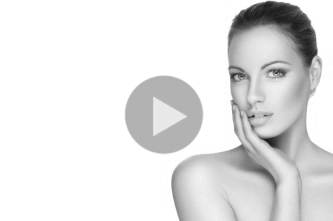Facts about anti-wrinkle treatment with botulinum toxin
| Wrinkle types | Expression lines |
|---|---|
| Duration | 30 mins |
| Anaesthesia | Numbing cream available upon request |
| Aftercare | Avoid physical exertion for at least 24 hours; no massages |
| Recovery time | None |
| Presentable | Immediately |
| Prices | From CHF 100: Please consult the price list for detailed pricing information. |
Botulinum toxin type A is one way of smoothing out your wrinkles. For over twenty years, practitioners have known about the therapeutic effect of this active substance for the treatment of Strabismus (squints) and neurological muscle disease.
Botulinum toxin has also been used in aesthetic procedures for several years now. It is a substance that can block the release of the neurotransmitter responsible for triggering muscle contractions. Botulinum toxin can also be used to treat excessive sweating. It is important to have a detailed consultation with a doctor about the risks and side effects.
Botulinum toxin
Botulinum toxin A is a prescription medication made from a naturally occurring bacterial protein. When injected into a muscle it blocks the nerve impulses, preventing that muscle from contracting in the usual way. Other nerve functions, such as the sense of feeling or touch through the skin, are not affected. Botulinum toxin A has long been used in the treatment of muscular cramp in the area around the eyes and forehead (such as an eyelid spasm). In Switzerland, permission to use it for the treatment of wrinkles has been restricted to the correction of frown lines on the forehead. Efforts are being made to acquire permission for other uses. The injection of very small quantities of botulinum toxin A inhibits the relevant facial muscle.
Treatment Options
Deep mimetic wrinkles can be corrected by means of an operation, by the injection of fillers or medication such as botulinum toxin A, or through a combination of procedures. Finding the most suitable solution depends upon the location and depth of the wrinkles.
The injections are administered using a very fine needle, ensuring that the treatment is relatively painless. On rare occasions the injection may initially cause a slight burning sensation.
Result
An improvement in glabellar wrinkles can generally be noticed within one week of treatment, with the peak effect usually visible within 4 weeks. The results last for 3 to 4 months. The safety and effectiveness of treatment on a more regular basis have not yet been investigated. It is therefore not recommended to have frequent treatment. Should the treating doctor deem it appropriate, repeat treatments can be administered if the effects of the previous injection have subsided. Repeat injections should not be administered more frequently than every 3 months.
Before using Botulinum Toxin
Please let us know
- if you are pregnant or breastfeeding (treatment cannot be performed during pregnancy or if you are breastfeeding), if you occasionally suffer from fever blisters/cold sores (injection into a particular area could trigger a new outbreak)
- if you have taken any blood-thinning medication in the 7 days prior to treatment (due to an increased risk of haematoma (effusions of blood) after the treatment)
- if you are aware that you have any nervous or muscular disorders (in a few cases treatment with botulinum toxin A is not possible)
- if you are taking aminoglycoside antibiotics (e.g. gentamicin, neomicin; treatment can only be carried out after the course of antibiotics has been completed)
Risks & Side effects
Based on the results of controlled clinical trials, 24% of patients can expect to experience undesirable effects as a result of treatment. Side effects may be associated with the treatment, the injection technique, or a combination of both.
Side effects generally manifest themselves within a few days of the injection and are usually only temporary. Localised muscle weakness is a known pharmacological effect of botulinum toxin. Blepharoptosis (drooping eyelid) is connected with the pharmacological effect of the medication and can be caused by the injection technique.
The following undesirable reactions have been observed after treatment with Vistabel
Reaction at the injection site
Frequent (1%–10%): localised pain/burning/stinging, oedemata and/or haematoma
Nervous system
Very frequent (>10%): headaches (13.3%)
Frequent (1%–10%): facial pain, localised muscle weakness
Occasional (0.1%–1%): dizziness, nausea, oral dryness, feeling of tension in the skin, paresthesia, twitching.
Eyes
Frequent (1%–10%): blepharoptosis
Occasional (0.1%–1%): eye pain, oedemata (face, eyelids, periorbita), eyelid inflammation (blepharitis), visual disturbances, sensitivity to light
Skin
Frequent (1%–10%): skin redness
Occasional (0.1%–1%): dry skin, itching
Immune system
Occasional (0.1%–1%): flu-like symptoms, general weakness, fever, infection
Psychological
Occasional (0.1%–1%): anxiety
Gastrointestinal disorders
Occasional (0.1%–1%): sickness
Contraindications
Known hypersensitivity to the active ingredients, or any of the components used in the formulation. General disturbances in muscular activity (e.g. myasthenia gravis or Lambert–Eaton myasthenic syndrome). Presence of infection at the planned injection site(s).
For additional information (in French and German) www.compendium.ch
Contact

PREVENTION-CENTER AG UTOSCHLOSS
Utoquai 31
8008 Zürich
How to get there
PREVENTION-CENTER AG ZUG
Aabachstrasse 8
6300 Zug
How to get there
PREVENTION-CENTER AG BERN
Kornhausplatz 7
3011 Bern
How to get there
VISITING HOURS
| MO - FR | 8 AM - 6 PM |
OVER THE PHONE
| MO - FR | 8 AM - 5 PM |


